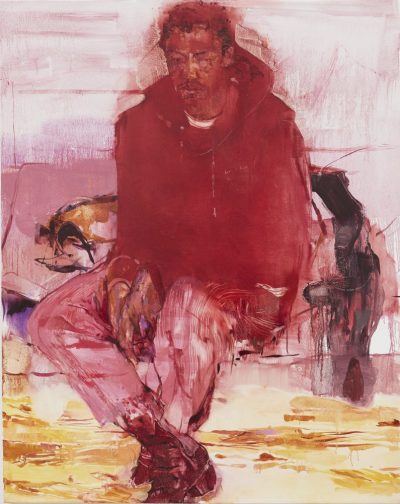Jennifer Packer’s intimate portraits of Black lives
Jennifer Packer’s intimate portraits of Black lives
By Aruna D'Souza
Published 2 December 2020
As the first major European show of Packer’s work opens, Aruna D’Souza celebrates the painter’s powerful repurposing of art historical tradition.
-
Aruna D’Souza is a writer on modern and contemporary art.
Against a sea of irregular black marks that dominates Jennifer Packer’s charcoal drawing Swim (2011; below, far right), a finely drawn rope, knotted at one end, dangles from the top edge of the composition. Five white spots of bare paper, interrupted by a few quick dots and lines, indicate the head, hands and feet of a swimmer who likely has just swung from the rope and landed with a splash in the water.
Packer barely deploys line – usually the defining aspect of drawing – instead using the side or flat top of the crayon to carve out of negative space an image that is both joyful and ominous. The pleasure of jumping into a cool pond on a hot day and floating weightlessly on the water exists alongside the relentlessness of the dark field that defines the swimmer’s body, and the dangling rope, which, thank goodness, ends in a knot and not a noose.
In this drawing and her oil-on-canvas portraits, exhibited in her first major European show at the Serpentine Gallery, Packer depicts people she loves and honours – friends, family, fellow artists, writers and curators, all of whom are Black – in a manner that insists upon their full humanity, that refuses the propensity of traditional portraiture to serve up those depicted to the viewer’s gaze, no matter how impressive or powerful they are.
-

Jennifer Packer, Jess, 2018.

Jennifer Packer, The Body Has Memory, 2018.

Jennifer Packer, Swim, 2011.
-
Packer’s portraits are as startlingly intimate as they are hard to grasp. The figures often merge into or barely coalesce from their backgrounds, and the sketchy, even agitated lines Packer employs in their depictions obscure as much as they reveal. In Jess (2018; above left), her friend’s crossed legs scarcely register as such, and her clasped hands are a miasma of interlaced fingers. The bodies of the artists hanging out in a painting studio in Jordan (2014) are rendered in thin washes of oil and scraped down with the palette knife, with just enough particularity to convey their individuality despite the sketchiness of Packer’s mark-making.
Sometimes insisting on the sovereignty of her subjects involves withdrawing them entirely from view. As the media fills with images of the broken bodies of victims of extra-judicial police murders, Packer presents us with alternative images of the lives that were ended: works like Say Her Name (2017; top), made in the wake of the death of Sandra Bland in police custody, offer up bouquets of flowers. The play between representation and abstraction in these paintings is almost impossible to parse, as they honour the lost by insisting on the fleeting and ungraspable beauty of life.
From the Autumn 2020 issue of RA Magazine, issued quarterly to Friends of the RA. Jennifer Packer: The Eye Is Not Satisfied With Seeing runs from 5 December – March 2021 at the Serpentine Gallery.
-
-

Enjoyed this article?
Become a Friend to receive RA Magazine
As well as free entry to all of our exhibitions, Friends of the RA enjoy one of Britain’s most respected art magazines, delivered directly to your door.
-







